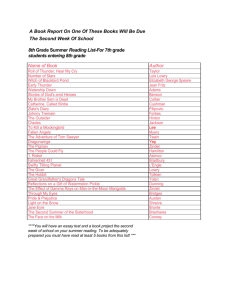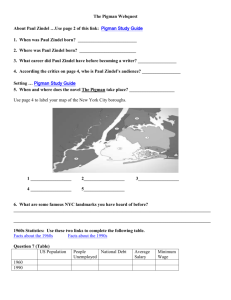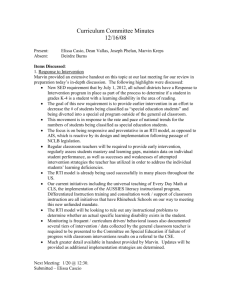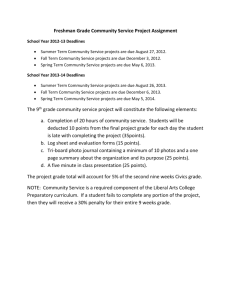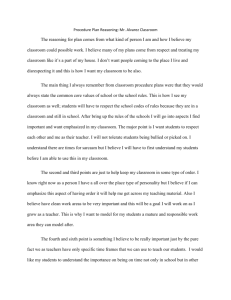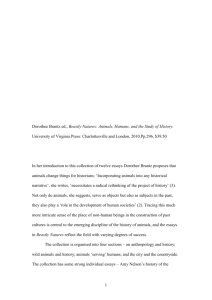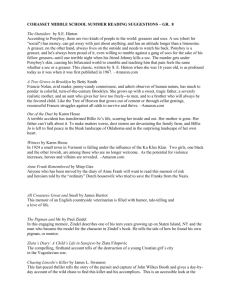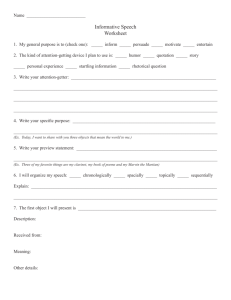memorandum
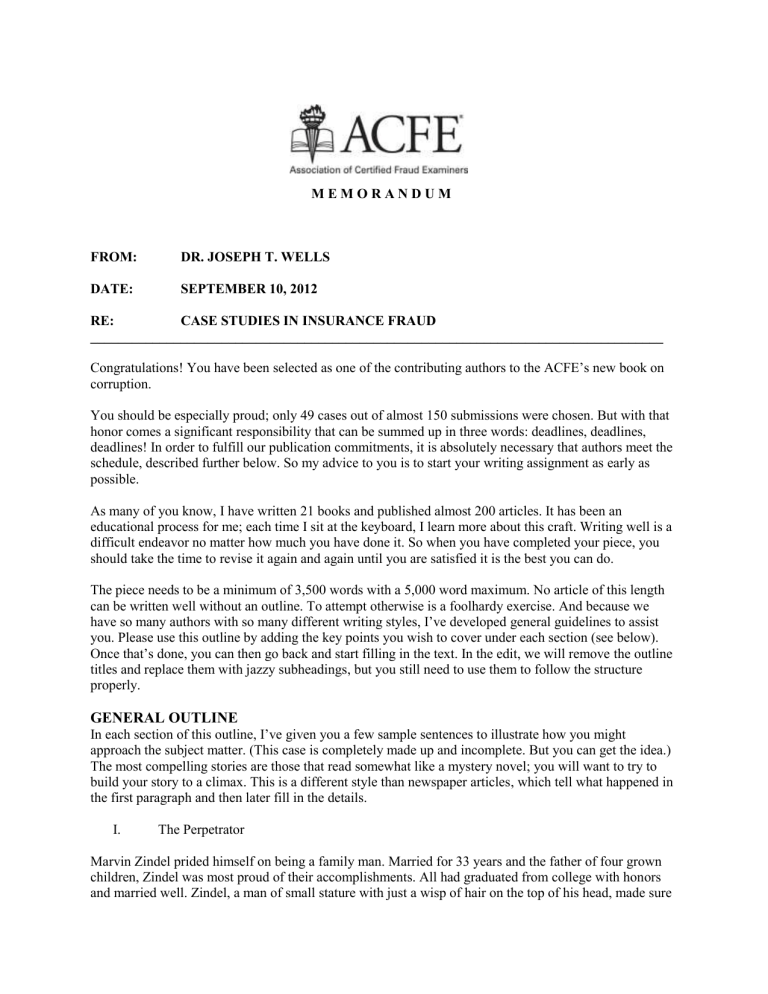
M E M O R A N D U M
FROM:
DATE:
DR. JOSEPH T. WELLS
SEPTEMBER 10, 2012
RE: CASE STUDIES IN INSURANCE FRAUD
___________________________________________________________________________________
Congratulations! You have been selected as one of the contributing authors to the ACFE’s new book on corruption.
You should be especially proud; only 49 cases out of almost 150 submissions were chosen. But with that honor comes a significant responsibility that can be summed up in three words: deadlines, deadlines, deadlines! In order to fulfill our publication commitments, it is absolutely necessary that authors meet the schedule, described further below. So my advice to you is to start your writing assignment as early as possible.
As many of you know, I have written 21 books and published almost 200 articles. It has been an educational process for me; each time I sit at the keyboard, I learn more about this craft. Writing well is a difficult endeavor no matter how much you have done it. So when you have completed your piece, you should take the time to revise it again and again until you are satisfied it is the best you can do.
The piece needs to be a minimum of 3,500 words with a 5,000 word maximum. No article of this length can be written well without an outline. To attempt otherwise is a foolhardy exercise. And because we have so many authors with so many different writing styles, I’ve developed general guidelines to assist you. Please use this outline by adding the key points you wish to cover under each section (see below).
Once that’s done, you can then go back and start filling in the text. In the edit, we will remove the outline titles and replace them with jazzy subheadings, but you still need to use them to follow the structure properly.
GENERAL OUTLINE
In each section of this outline, I’ve given you a few sample sentences to illustrate how you might approach the subject matter. (This case is completely made up and incomplete. But you can get the idea.)
The most compelling stories are those that read somewhat like a mystery novel; you will want to try to build your story to a climax. This is a different style than newspaper articles, which tell what happened in the first paragraph and then later fill in the details.
I.
The Perpetrator
Marvin Zindel prided himself on being a family man. Married for 33 years and the father of four grown children, Zindel was most proud of their accomplishments. All had graduated from college with honors and married well. Zindel, a man of small stature with just a wisp of hair on the top of his head, made sure
that his kids received the opportunities he never had as a child. You could tell when Marvin spoke that his children were the most important thing in the world to him. He would do anything for them ─ anything.
II.
The Company
Wharton Manufacturing Company was established in 1910 by James “Sonny” Wharton, Jr., to build agricultural implements. But Sonny eventually saw a greater market in those new-fangled “horseless carriages” and switched to making glass for enclosing them. In the 1950s, after Sonny’s death, the company went public. Today, Wharton Glass Company is the nation’s second-largest supplier of windshields to the auto industry. It employs 7,000 people in four plant locations.
III.
The Initial Discovery
I was one of two internal auditors employed by Wharton Glass. In addition to the mundane, I was also assigned the occasional fraud case, which was typically committed by a bookkeeper or other accounting employee with access to cash. Because we prided ourselves on good internal controls, most of these cases were fairly small and discovered quickly. But that certainly wasn’t the same with Marvin Zindel,
Wharton’s vice president and chief purchasing officer.
One cold, wintry morning, I was enjoying my first cup of coffee when the phone rang. An unfamiliar male voice on the other end of the line said, “You don’t know who this is. But I am calling because this company has a big problem with one of its employees, Marvin Zindel. He is stealing you blind..”
“What are you talking about?” I asked. I had known Marvin for years and had a great opinion of him.
IV.
The Investigation
I met with Gina Summers, the other internal auditor and computer forensics specialist, and told her of the mysterious telephone call. “Well, Mr. Zindel controls millions of dollars of purchases annually,” she observed. “I don’t think that we can sit on this information; we’ve got to check it out.” Together, we went to the office of our boss, Ted Lampkin, the company’s chief financial officer.
Lampkin had a razor-sharp mind; he knew the company inside-out. And he was a no-nonsense guy. “I’d hate to think old Marvin would be defrauding the company,” Lampkin said. “But as much control as he exercises, he could sure pull it off. The first thing we need to do is check with in-house counsel and then the two of you should start digging.”
V.
The Outcome of the Investigation
Once we had all of the documentation and Zindel’s written confession, the evidence was turned over to our legal counsel, who furnished it to the District Attorney’s office. After reviewing our report and evidence, the prosecutor said, “This is just about as air-tight of a case as I’ve seen.” Marvin pled guilty to felony theft, was ordered to pay full restitution, and spent two-and-a-half years in state prison. After his release, I heard that he moved to live with one of his children.
VI.
Lessons Learned
My colleague Gina and I learned a lot about investigating a complicated fraud case that we didn’t know before. For one, we now have a greater appreciation of how important it is to maintain the chain of custody over crucial evidence. Our in-house counsel was a great help in that regard. We also learned that there were critical internal control deficiencies.
2
VII. Recommendations to Prevent Future Occurrences
Although fraud is probably impossible to eliminate completely, we have made the following recommendations in our company.
1.
Install a fraud hotline.
2.
Institute additional controls over our purchasing department. Randomly test the authenticity of purchases.
3.
Etc, etc. (Please elaborate on each recommendation in your final case study.)
GUIDELINES
1.
Write in the first person
Use “I,” “me,” and “you” in place of “the writer,” “this internal auditor” and similar terms.
2.
Do not use the actual identities of the perpetrator or the company
In the main introduction to the book, we will disclose that the identities of the company and other appropriate persons have been changed. Please use some imagination when coming up with names; e.g., avoid “John Jones,” “Mary Smith,” and “ABC Company.”
3.
Do not use exact dates
One key to a good book is to make it pertinent for years to come. Identifying specific dates can quickly antiquate a publication. Please refrain from referring to precise years.
The following is the incorrect use of a date for this book :
On March 28 th , 2007, Susan was sentenced to 15 years in prison.
Here is the correct way to use a date :
The following March, Susan was sentenced to 15 years in prison.
OR
On March 28 th , Susan was sentenced to 15 years in prison.
4.
Tell the story in rich personal detail
Simply reading facts gets very tedious for most of us. Good authors tell the story in rich personal detail ─ what the fraudster looks like, his/her family background, even the surroundings, such as your windowless cubicle, etc. The more of these details you add, the more authentic and readable your story will be.
5.
Use short, declarative sentences
Don’t make your story look like a legal brief. Short, declarative sentences should be the rule, not the exception. They will make your work easier to read.
6.
Use quotes wherever possible
Obviously, unless you have tape recorded all of the conversations in your case, exact quotes will not be possible. That’s okay; what you are attempting to do is to pull the reader into the story. Don’t hesitate to paraphrase quotes in order to add drama.
3
7.
Minimize jargon
Remember that you are writing to a broad audience, one not familiar with buzz-words that are common to the accounting world. So don’t use terms like FIFO, big bath, or EBITDA, unless they are necessary to the story and unless you explain what they mean.
8.
Do not editorialize
This book is not a forum for us to rant against the inequities in the criminal justice system and the stupidity of corporate leaders who don’t take fraud seriously. If you editorialize, it will detract from your overall message and lessen the credibility of your story.
9.
Adhere to the outline structure
Please follow the aforementioned outline so that each case study will be consistent and reader-friendly.
10.
Proofread
To expedite the editing process, be sure to proofread your case study a few times. Sometimes it’s difficult to see a piece that you’ve worked closely with so it may be beneficial to have a coworker, friend, or spouse read over it too.
11.
Word count, font, and spacing
As stated, your case study’s final word count should be no less than 3,500 words and no more than 5,000.
That comes out to approximately 10 to 14 pages, spaced at 1.5. Please use 12 point font in Times New
Roman.
DEADLINES
As alluded to earlier, writers live or die by deadlines. This situation is no different, except that we are dealing with many writers, making coordination all that much more important. If any writer fails to adhere to the below deadlines, he or she will be automatically dropped from the project. I trust that you realize that I am not being unreasonable; we are working to fulfill our obligations to Wiley Publishing.
Feel free to submit your work ahead of schedule. If you know now that you cannot meet the deadline or wish to withdraw from the project, please immediately notify Laura Hymes ( lhymes@ACFE.com
), the project manager. Should you prefer to phone, her direct line number is 512-276-8120 or you may call the main switchboard at 1-800-245-3321 and ask for Ms. Hymes. However, e-mail is the most expeditious way to reach her.
October 10, 2012: Preliminary Outline and First 700 Words of Story
Use Roman numerals I–VII above as a starting point. For each Roman numeral, there should be “A,” “B,” etc., as necessary. Here is just an example; feel free to use a different order for the sub-topics.
I.
The Perpetrator
A.
Name
B.
Educational Background
C.
Family
D.
Work History
E.
Unusual Personality Traits
4
Once you have your outline for all of the Roman numerals, write the first 700 words of your story. Do not attempt to write the complete story at this stage.
Laura Hymes will want to review your material first to see that you are on the right track. If there are changes that need to be made at that point, she will let you know.
November 26, 2012: Final Outline and First 1,500 Words of Story
It is normal to make changes in your preliminary outline when you sit down to actually write up your case. This deadline ensures that you have your final outline in order so that few, if any, changes will be necessary after this. Like above, do not attempt to complete your story at this stage. If the 700 words above have been accepted, then it will be necessary to write another 800 for the 1,500 word total. Laura again will review your work and let you know of your progress.
January 15, 2013: Final Story
In order for us to meet our publishing commitments, your final story must be received by January 15,
2013; no exceptions. It will take us about a month to complete all of the edits. The final draft will be sent back to you for approval before February 15, 2013. Nothing will be printed in your name that you have not seen or approved.
EDITING AND CONTACT INFORMATION
A good book is a partnership between the author and the editor; one cannot exist without the other. Very rarely is there an unresolved issue between a writer and an editor. But if there is, the editor’s decision prevails.
Your submissions should be in Microsoft Word© format to Laura at lhymes@ACFE.com
. Once her edits are complete, she will furnish them to me for further editing and final approval. Thank you for your assistance in this much-needed book. I am confident that we will produce a work that makes us all proud.
5
